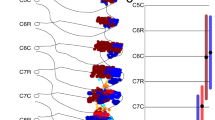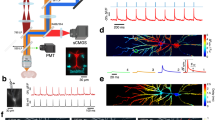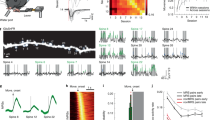Abstract
The dendrites of spinal motoneurons amplify synaptic inputs to a marked degree through persistent inward currents (PICs). Dendritic amplification is subject to neuromodulatory control from the brainstem by axons releasing the monoamines serotonin and norepinephrine; however, the monoaminergic projection to the cord is diffusely organized and does not allow independent adjustment of amplification in different motor pools. Using in vivo voltage-clamp techniques, here we show that dendritic PICs in ankle extensor motoneurons in the cat are reduced about 50% by small rotations (±10°) of the ankle joint. This reduction is primarily due to reciprocal inhibition, a tightly focused input shared only among strict muscle antagonists. These results demonstrate how a specific change in limb position can regulate intrinsic cellular properties set by a background of diffuse descending neuromodulation.
This is a preview of subscription content, access via your institution
Access options
Subscribe to this journal
Receive 12 print issues and online access
$259.00 per year
only $21.58 per issue
Buy this article
- Purchase on SpringerLink
- Instant access to full article PDF
Prices may be subject to local taxes which are calculated during checkout





Similar content being viewed by others
References
Lee, R.H. & Heckman, C.J. Influence of voltage-sensitive dendritic conductances on bistable firing and effective synaptic current in cat spinal motoneurons in vivo. J. Neurophysiol. 76, 2107–2110 (1996).
Hounsgaard, J. & Kiehn, O. Calcium spikes and calcium plateaux evoked by differential polarization in dendrites of turtle motoneurones in vitro. J. Physiol. (Lond.) 468, 245–259 (1993).
Bennett, D.J., Hultborn, H., Fedirchuk, B. & Gorassini, M. Synaptic activation of plateaus in hindlimb motoneurons of decerebrate cats. J. Neurophysiol. 80, 2023–2037 (1998).
Carlin, K.P., Jones, K.E., Jiang, Z., Jordan, L.M. & Brownstone, R.M. Dendritic L-type calcium currents in mouse spinal motoneurons: implications for bistability. Eur. J. Neurosci. 12, 1635–1646 (2000).
Heckman, C.J., Lee, R.H. & Brownstone, R.M. Hyperexcitable dendrites in motoneurons and their neuromodulatory control during motor behavior. Trends Neurosci. 26, 688–695 (2003).
Hultborn, H., Brownstone, R.B., Toth, T.I. & Gossard, J.P. Key mechanisms for setting the input-output gain across the motoneuron pool. Prog. Brain Res. 143, 77–95 (2004).
Alaburda, A., Perrier, J.F. & Hounsgaard, J. Mechanisms causing plateau potentials in spinal motoneurones. Adv. Exp. Med. Biol. 508, 219–226 (2002).
Hultborn, H., Denton, M.E., Wienecke, J. & Nielsen, J.B. Variable amplification of synaptic input to cat spinal motoneurones by dendritic persistent inward current. J. Physiol. (Lond.) 552, 945–952 (2003).
Lee, R.H. & Heckman, C.J. Adjustable amplification of synaptic input in the dendrites of spinal motoneurons in vivo. J. Neurosci. 20, 6734–6740 (2000).
Cushing, S., Bui, T. & Rose, P.K. Effect of nonlinear summation of synaptic currents on the input-output properties of spinal motoneurons. J. Neurophysiol. 94, 3465–3478 (2005).
Jacobs, B.L., Martin-Cora, F.J. & Fornal, C.A. Activity of medullary serotonergic neurons in freely moving animals. Brain Res. Brain Res. Rev. 40, 45–52 (2002).
Aston-Jones, G., Chen, S., Zhu, Y. & Oshinsky, M.L. A neural circuit for circadian regulation of arousal. Nat. Neurosci. 4, 732–738 (2001).
Björklund, A. & Skagerberg, G. Descending monoaminergic projections to the spinal cord. in Brain Stem Control of Spinal Mechanisms (eds. Sjolund, B. & Bjorklund, A.) 55–88 (Elsevier Biomedical Press, Amsterdam, 1982).
Kuo, J.J., Lee, R.H., Johnson, M.D., Heckman, H.M. & Heckman, C.J. Active dendritic integration of inhibitory synaptic inputs in vivo. J. Neurophysiol. 90, 3617–3624 (2003).
Fyffe, R.E.W. Spinal motoneurons: synaptic inputs and receptor organization. in Motor Biology of the Spinal Cord (ed. Cope, T.C.) 21–46 (CRC, London, 2001).
Hounsgaard, J., Hultborn, H., Jespersen, B. & Kiehn, O. Bistability of α-motoneurones in the decerebrate cat and in the acute spinal cat after intravenous 5-hydroxytryptophan. J. Physiol. (Lond.) 405, 345–367 (1988).
Lee, R.H., Kuo, J.J., Jiang, M.C. & Heckman, C.J. Influence of active dendritic currents on input-output processing in spinal motoneurons in vivo. J. Neurophysiol. 89, 27–39 (2003).
Lee, R.H. & Heckman, C.J. Bistability in spinal motoneurons in vivo: systematic variations in rhythmic firing patterns. J. Neurophysiol. 80, 572–582 (1998).
Lee, R.H. & Heckman, C.J. Bistability in spinal motoneurons in vivo: systematic variations in persistent inward currents. J. Neurophysiol. 80, 583–593 (1998).
Jankowska, E. Interneuronal relay in spinal pathways from proprioceptors. Prog. Neurobiol. 38, 335–378 (1992).
Nichols, T.R., Cope, T.C. & Abelew, T.A. Rapid spinal mechanisms of motor coordination. Exerc. Sport. Sci. Rev. 27, 255–284 (1999).
Svirskis, G. & Hounsgaard, J. Depolarization-induced facilitation of a plateau-generating current in ventral horn neurons in the turtle spinal cord. J. Neurophysiol. 78, 1740–1742 (1997).
Bennett, D.J., Hultborn, H., Fedirchuk, B. & Gorassini, M. Short-term plasticity in hindlimb motoneurons of decerebrate cats. J. Neurophysiol. 80, 2038–2045 (1998).
Powers, R.K. & Binder, M.D. Input-output functions of mammalian motoneurons. Rev. Physiol. Biochem. Pharmacol. 143, 137–263 (2001).
Rose, P.K., Keirstead, S.A. & Vanner, S.J. A quantitative analysis of the geometry of cat motoneurons innervating neck and shoulder muscles. J. Comp. Neurol. 239, 89–107 (1985).
Cullheim, S., Fleshman, J.W., Glenn, L.L. & Burke, R.E. Three-dimensional architecture of dendritic trees in type-identified α-motoneurons. J. Comp. Neurol. 255, 82–96 (1987).
LaBella, L.A. & McCrea, D.A. Evidence for restricted central convergence of cutaneous afferents on an excitatory reflex pathway to medial gastrocnemius motoneurons. J. Neurophysiol. 64, 403–412 (1990).
Stephens, J.A., Reinking, R.M. & Stuart, D.G. Tendon organs of cat medial gastrocnemius: responses to active and passive forces as a function of muscle length. J. Neurophysiol. 38, 1217–1231 (1975).
Cleland, C.L. & Rymer, W.Z. Neural mechanisms underlying the clasp-knife reflex in the cat. I. Characteristics of the reflex. J. Neurophysiol. 64, 1303–1318 (1990).
Hammar, I. & Jankowska, E. Modulatory effects of α1-, α2-, and β-receptor agonists on feline spinal interneurons with monosynaptic input from group I muscle afferents. J. Neurosci. 23, 332–338 (2003).
Matthews, P.B.C. Mammalian muscle receptors and their central actions. in Monographs of the Physiological Society, Vol. 23 (eds. Davson, H., Greenfield, A.D.M., Whittam, R. & Brindley, G.S.) 1–630 (Edward Arnold Ltd., London, 1972).
Jankowska, E. Spinal interneuronal systems: identification, multifunctional character and reconfigurations in mammals. J. Physiol. (Lond.) 533, 31–40 (2001).
Machacek, D.W., Garraway, S.M., Shay, B.L. & Hochman, S. Serotonin 5-HT2 receptor activation induces a long-lasting amplification of spinal reflex actions in the rat. J. Physiol. (Lond.) 537, 201–207 (2001).
Binder, M.D., Robinson, F.R. & Powers, R.K. Distribution of effective synaptic currents in cat triceps surae motoneurons. VI. Contralateral pyramidal tract. J. Neurophysiol. 80, 241–248 (1998).
Powers, R.K., Robinson, F.R., Konodi, M.A. & Binder, M.D. Distribution of rubrospinal synaptic input to cat triceps surae motoneurons. J. Neurophysiol. 70, 1460–1468 (1993).
Heckman, C.J. & Binder, M.D. Analysis of effective synaptic currents generated by homonymous Ia afferent fibers in motoneurons of the cat. J. Neurophysiol. 60, 1946–1966 (1988).
Binder, M.D. & Stuart, D.G. Motor unit-muscle receptor interactions: design features of the neuromuscular control system. in Spinal and Supraspinal Mechanisms of Voluntary Motor Control and Locomotion Vol. 8 (ed. Desmedt, J.E.) 72–98 (Karger, Basel, 1981).
Shefchyk, S.J. & Jordan, L.M. Motoneuron input-resistance changes during fictive locomotion produced by stimulation of the mesencephalic locomotor region. J. Neurophysiol. 54, 1101–1108 (1985).
Brownstone, R.M., Gossard, J.P. & Hultborn, H. Voltage-dependent excitation of motoneurones from spinal locomotor centres in the cat. Exp. Brain Res. 102, 34–44 (1994).
Fedirchuk, B. & Dai, Y. Monoamines increase the excitability of spinal neurones in the neonatal rat by hyperpolarizing the threshold for action potential production. J. Physiol. (Lond.) 557, 355–361 (2004).
Krawitz, S., Fedirchuk, B., Dai, Y., Jordan, L.M. & McCrea, D.A. State-dependent hyperpolarization of voltage threshold enhances motoneurone excitability during fictive locomotion in the cat. J. Physiol. (Lond.) 532, 271–281 (2001).
Svirskis, G. & Hounsgaard, J. Transmitter regulation of plateau properties in turtle motoneurons. J. Neurophysiol. 79, 45–50 (1998).
Baldissera, F., Hultborn, H. & Illert, M. Integration in spinal neuronal systems. in Handbook of Physiology. Section 1: The Nervous System. Vol. 2: Motor Control, part 1 (ed. Brooks, V.B.) 509–595 (American Physiological Society, Bethesda, 1981).
Curtis, D.R. & Lacey, G. Prolonged GABAB receptor-mediated synaptic inhibition in the cat spinal cord: an in vivo study. Exp. Brain Res. 121, 319–333 (1998).
Bowery, N.G. et al. International Union of Pharmacology. XXXIII. Mammalian γ-aminobutyric acid B receptors: structure and function. Pharmacol. Rev. 54, 247–264 (2002).
Crone, C., Hultborn, H., Jespersen, B. & Nielsen, J. Reciprocal Ia inhibition between ankle flexors and extensors in man. J. Physiol. (Lond.) 389, 163–185 (1987).
Wargon, I. et al. The disynaptic group I inhibition between wrist flexor and extensor muscles revisited in humans. Exp. Brain Res. 168, 203–217 (2006).
Nielsen, J., Crone, C., Sinkjaer, T., Toft, E. & Hultborn, H. Central control of reciprocal inhibition during fictive dorsiflexion in man. Exp. Brain Res. 104, 99–106 (1995).
Chen, X.Y., Chen, L., Chen, Y. & Wolpaw, J.R. Operant conditioning of reciprocal inhibition in rat soleus muscle. J. Neurophysiol. 96, 2144–2150 (2006).
Chen, Y. et al. The interaction of a new motor skill and an old one: H-reflex conditioning and locomotion in rats. J. Neurosci. 25, 6898–6906 (2005).
Acknowledgements
We thank J. Schuster for comments on the manuscript and assistance with data collection; H. Maas and J. Pitman for discussion and interpretation of the data and manuscript; A. Daub for writing the robot protocols; and R. Lee for feedback on experimental methods. This work was partially supported by the Foundation for Physical Therapy, Promotion of Doctoral Studies, Viva J. Erickson Scholarship (to A.S.H.), a US National Research Service Award, Pre-doctoral Fellowship (5F31NS048757-03 to A.S.H.) and a grant from the US National Institutes of Health (NINDS NS034282 to C.J.H.).
Author information
Authors and Affiliations
Contributions
A.S.H. and C.J.H. designed the experiments. A.S.H. collected and analyzed all data for experiments in Figures 2,3,4,5 and Supplementary Figure 1. M.D.J. and J.F.M. performed the surgical preparation and assisted with data collection for Figures 2,3,4,5 and Supplementary Figure. 1. Data interpretation and manuscript preparation were done by A.S.H. and C.J.H. with assistance from M.D.J. and J.F.M.
Corresponding author
Ethics declarations
Competing interests
The authors declare no competing financial interests.
Supplementary information
Supplementary Fig. 1
The dendritic PIC is suppressed by synaptic inhibition, but not by synaptic excitation. (PDF 46 kb)
Rights and permissions
About this article
Cite this article
Hyngstrom, A., Johnson, M., Miller, J. et al. Intrinsic electrical properties of spinal motoneurons vary with joint angle. Nat Neurosci 10, 363–369 (2007). https://doi.org/10.1038/nn1852
Received:
Accepted:
Published:
Issue date:
DOI: https://doi.org/10.1038/nn1852
This article is cited by
-
Shoulder position and handedness differentially affect excitability and intracortical inhibition of hand muscles
Experimental Brain Research (2021)
-
Intrinsic motoneuron excitability is reduced in soleus and tibialis anterior of older adults
GeroScience (2021)
-
Firing rate trajectories of human occipitofrontalis motor units in response to triangular voluntary contraction intensity
Experimental Brain Research (2021)
-
Involuntary sustained firing of plantar flexor motor neurones: effect of electrical stimulation parameters during tendon vibration
European Journal of Applied Physiology (2021)
-
Posture interacts with arm weight support to modulate corticomotor excitability to the upper limb
Experimental Brain Research (2017)



